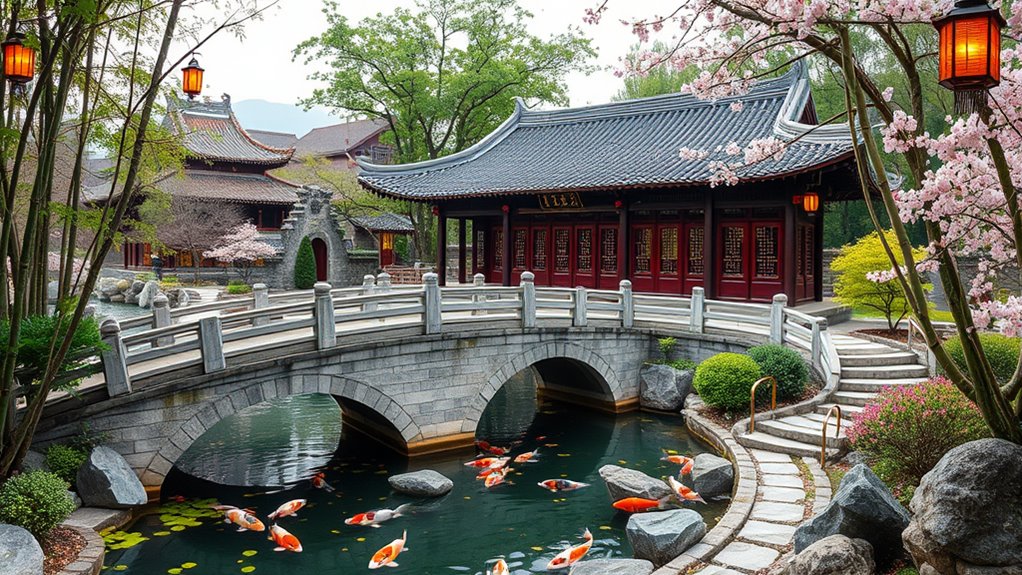In traditional Chinese garden design, you’ll see the harmonious use of water and rocks, symbolizing vitality and stability, carefully arranged to foster balance and serenity. Pavilions are thoughtfully placed to frame scenic views and invite reflection, while winding pathways and walls guide your movement and create intimate spaces. Symbolic plants like pine and bamboo add meaning, and artistic touches such as calligraphy and carvings enrich the environment. Exploring these elements reveals a deep harmony worth discovering further.
Key Takeaways
- Incorporation of water features and rocks to symbolize vitality, stability, and natural landscapes.
- Strategic placement of pavilions and pathways to enhance harmony, scenic views, and flow within the garden.
- Use of symbolic plants like pine and bamboo to represent resilience, longevity, and positive qualities.
- Integration of walls and curved walkways to guide movement and create aesthetic rhythm.
- Artistic details such as calligraphy, carvings, and murals to express cultural values and elevate the garden’s elegance.
The Significance of Water and Rock Arrangements
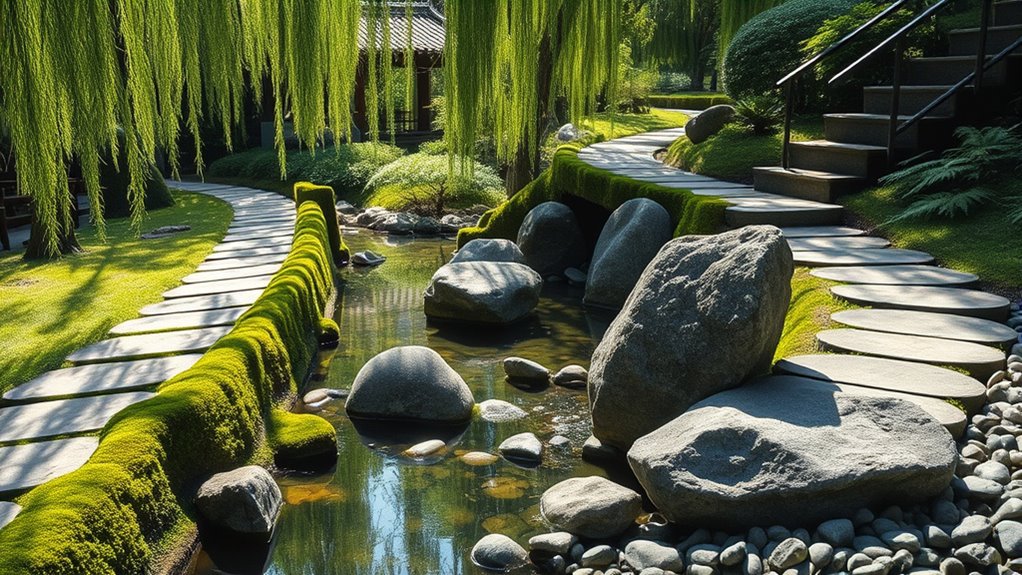
Water and rocks are fundamental elements in traditional Chinese garden design, shaping the garden’s mood and symbolism. In feng shui, water represents vitality and flow, attracting positive energy and good fortune. Its placement influences the harmony of the space, creating a sense of balance and serenity. Rocks, on the other hand, symbolize stability and strength, often representing mountains or enduring qualities. Their arrangement reflects cultural symbolism, emphasizing natural harmony and philosophical ideals. Carefully positioning water and rocks enhances the garden’s spiritual ambiance and aesthetic appeal. When you design with these elements, you invite a sense of tranquility and auspiciousness, making the garden a reflection of both natural beauty and cultural values. Mastering their arrangement is key to creating a harmonious, meaningful space. Additionally, understanding the feng shui principles behind these elements can help ensure the garden promotes health, happiness, and positive energy flow.
The Role of Pavilion and Pavilion Placement
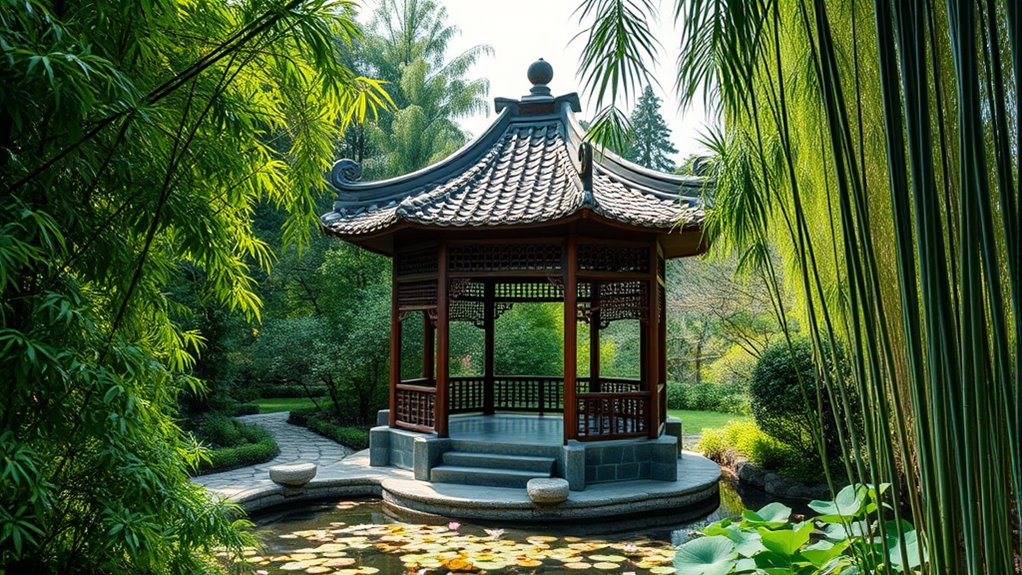
Pavilions serve as focal points in traditional Chinese gardens, offering spaces for rest, contemplation, and social gatherings. Their placement is carefully considered to enhance the garden’s harmony, often positioned to frame scenic views or near water features. Pavilion orientation plays a vital role, ensuring the structure faces desirable vistas or captures ideal sunlight, creating a tranquil atmosphere. Pavilion architecture reflects cultural symbolism and aesthetic principles, with curved roofs and intricate woodwork that blend seamlessly with natural surroundings. Proper placement of pavilions guides your movement through the garden, inviting you to pause and appreciate the landscape. Whether situated on a hill, beside a pond, or amidst lush foliage, the pavilion’s location and architectural design deepen your experience of the garden’s harmony and balance. Incorporating traditional design elements, such as carefully chosen materials and harmonious layout, further enhances the pavilion’s role within the garden.
Pathways and Walls: Guiding the Journey
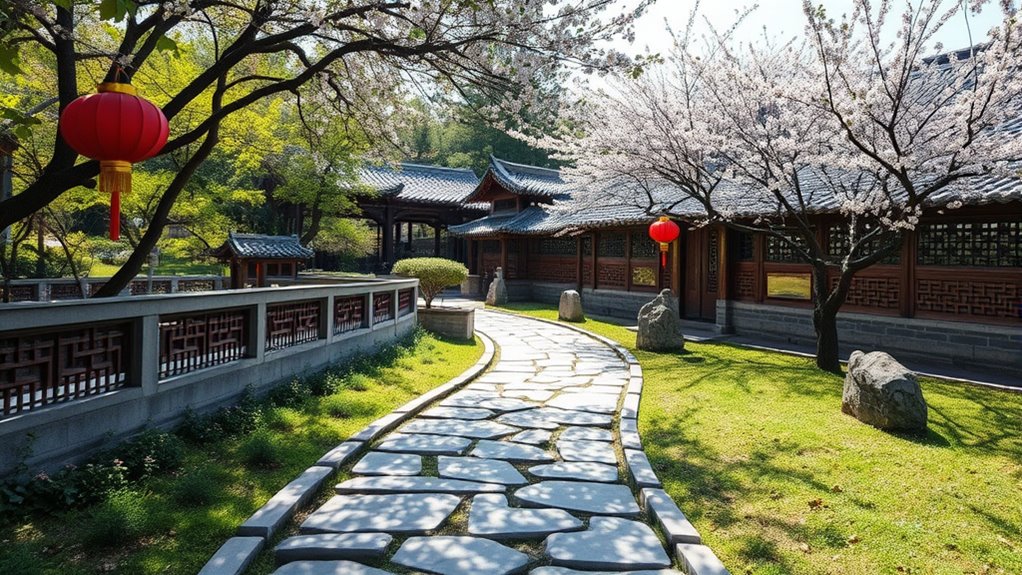
Pathways and walls are essential tools in traditional Chinese garden design, shaping your journey and encouraging exploration. They serve not only functional purposes but also carry garden symbolism, guiding your movement and creating a sense of flow. Meandering paths lead you through different scenic spots, emphasizing aesthetic harmony by connecting various elements seamlessly. Walls define spaces subtly, offering privacy and framing views while maintaining balance within the landscape. Curved walkways evoke a natural, tranquil feeling, inviting you to pause and reflect. The strategic placement of pathways and walls helps craft a harmonious rhythm, ensuring each step reveals a new view or secret corner. Additionally, garden symbolism plays a significant role in their design, imbuing the landscape with deeper cultural meaning. Together, they craft an immersive experience that respects traditional principles, blending function with beauty to enhance your connection to the garden’s spiritual and aesthetic essence.
Symbolic Plantings and Natural Elements
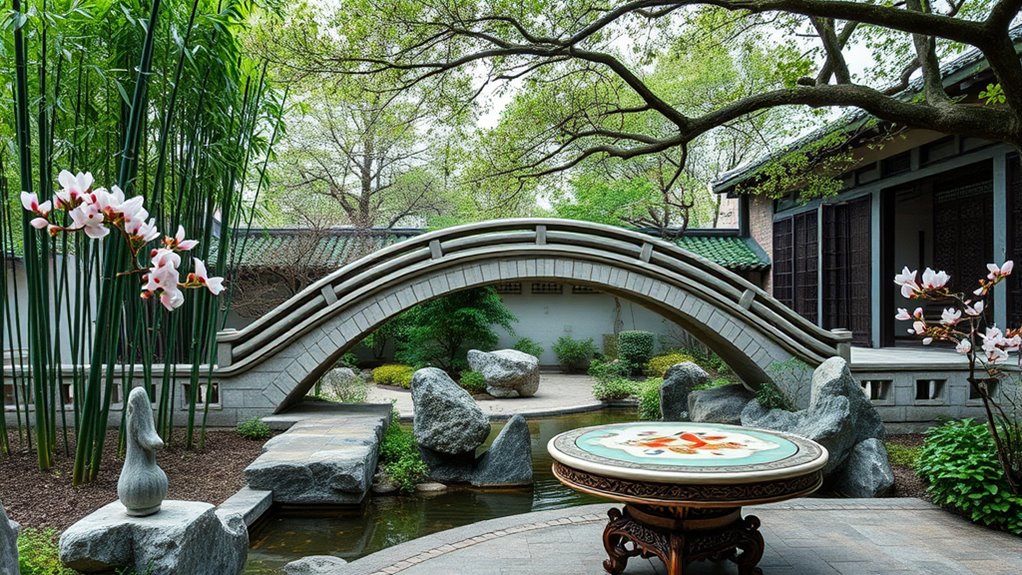
In traditional Chinese gardens, plantings and natural elements are carefully chosen to deepen the symbolic meaning and enhance the overall harmony. You’ll notice that plant selection reflects garden symbolism, conveying wishes for longevity, happiness, or resilience. Specific plants like pine trees symbolize endurance, while bamboo represents flexibility and strength. Water features and rocks are also integrated to evoke natural landscapes and spiritual harmony. These elements work together to create a balanced environment that embodies philosophical ideals. garden symbolism plays a vital role in shaping the emotional and spiritual experience within the space.
The Use of Calligraphy and Artistic Details

Calligraphy and artistic details are integral to traditional Chinese garden design, serving as visual expressions of cultural values and aesthetic principles. You’ll notice that calligraphy aesthetics are carefully integrated into walls, plaques, and rocks, adding a refined elegance. These artistic embellishments convey poetry, philosophy, or blessings, enriching the garden’s ambiance. The following table highlights common elements:
| Artistic Element | Purpose |
|---|---|
| Calligraphy inscriptions | Express cultural ideals and poetic beauty |
| Carved stone tablets | Showcase calligraphy and artistic craftsmanship |
| Painted murals | Enhance visual appeal and storytelling |
| Sculpted brush motifs | Add subtle artistic embellishments |
| Decorative lanterns | Incorporate calligraphy and balance aesthetics |
These details deepen your experience by blending visual art with natural harmony. Floating on water elements often symbolize harmony and tranquility, enhancing the garden’s peaceful atmosphere.
Frequently Asked Questions
How Do Garden Elements Reflect Chinese Philosophical Beliefs?
You see that garden elements reflect Chinese philosophical beliefs through symbolic plantings and water symbolism. For instance, bamboo represents resilience and humility, while plum blossoms symbolize perseverance. Water features, like ponds and streams, embody harmony and flow, illustrating Taoist ideals of balance and natural order. By incorporating these elements, you create a space that embodies philosophical principles, fostering tranquility and a deep connection with nature.
What Materials Are Traditionally Used in Chinese Garden Construction?
You’ll notice that traditional Chinese gardens mainly use stone pavements and wood pavilions. Stone is chosen for pathways and decorative elements because it’s durable and symbolizes stability. Wood is used for pavilions, bridges, and furniture, offering a natural, harmonious feel that blends with the landscape. These materials reflect Chinese aesthetics, emphasizing balance and harmony with nature, and are carefully selected to create a serene, enduring environment.
How Do Seasonal Changes Impact Garden Design?
Imagine your garden as a timeless app, adapting seamlessly to seasonal changes. You’ll notice seasonal plant variations bring vibrant colors in spring and calming hues in winter. Water feature adaptations, like adjusting flows or adding ice sculptures, enhance serenity or playfulness. These changes help you enjoy your garden year-round, reflecting nature’s rhythm. Embrace these shifts to deepen your connection with the space, making every visit a new experience.
Are There Regional Differences in Traditional Chinese Gardens?
Yes, regional styles and local materials shape traditional Chinese gardens considerably. In southern regions, you’ll find lush, water-rich landscapes with delicate rocks and greenery, while northern gardens emphasize formal layouts, pavilions, and hardy plants suited to colder climates. You adapt these designs by using local materials, like specific stones or wood, creating a harmonious blend of natural surroundings and cultural expression unique to each area.
How Do Gardens Incorporate Aspects of Chinese Poetry and Literature?
Imagine strolling through a garden where each path whispers poetry and every pond reflects literary symbolism. You see poetry-inspired landscapes woven into the design, with rocks and plants symbolizing themes from Chinese literature. These gardens seamlessly integrate literary symbolism, turning natural elements into living verses. You become part of a poetic story, where the landscape itself breathes the beauty and depth of Chinese poetry and literature, inviting reflection and inspiration at every turn.
Conclusion
As you explore a traditional Chinese garden, you become part of a living painting, where every element weaves together like a delicate silk thread. Water, rocks, pavilions, and plants guide your journey, creating a harmonious balance. Artistic details and calligraphy add depth, inviting reflection. Embrace these design elements, and you’ll feel immersed in a tranquil world, where nature and artistry blend seamlessly—like a gentle brushstroke on a timeless scroll.

